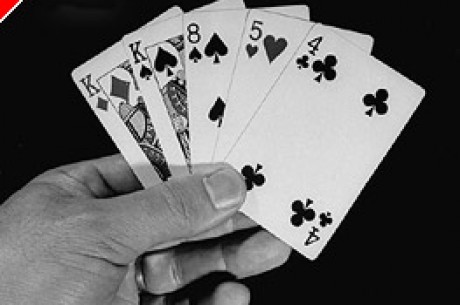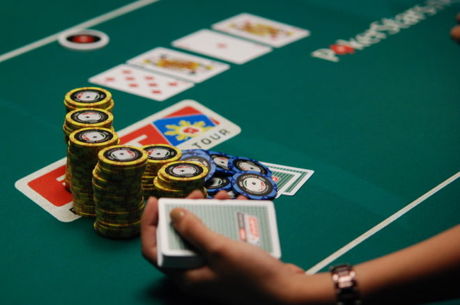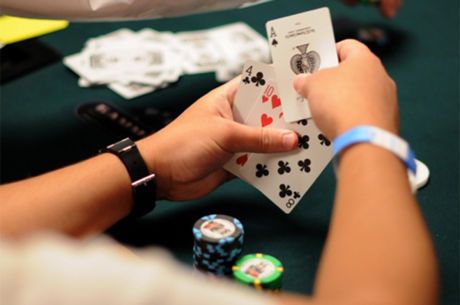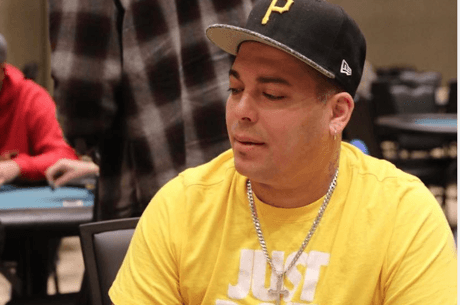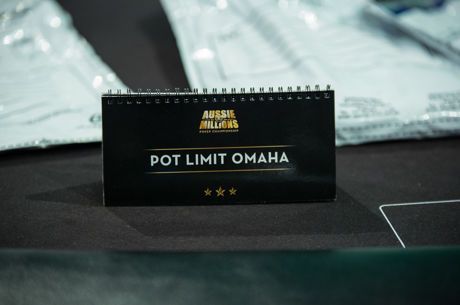Introduction to Omaha Part III. Split the difference
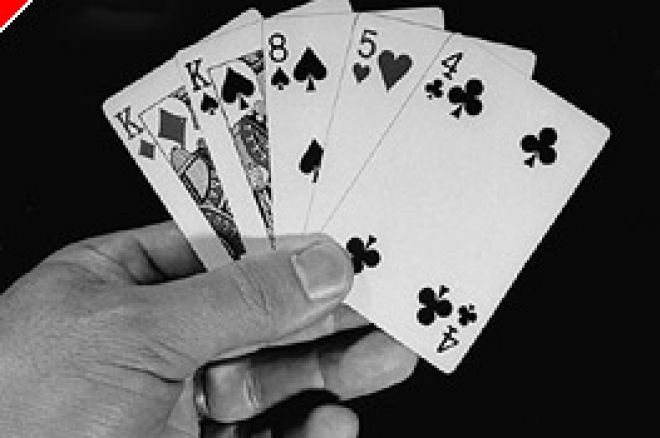
Introduction
Welcome to my third article for on-line players new to the poker game of Omaha. If you read my first two articles in this series, you will know I am based in England and play most forms of on-line poker on a regular basis. My aim in writing these columns is to reflect the experience of playing on-line bearing in mind that this is a hobby for most of you (and me) rather than a full-time activity.
In this article, I examine the differences in the two popular forms of Omaha typically available to you on-line; Omaha High and Omaha Split.
Omaha High
It is in the natural order of things that most beginners in Omaha will first play Omaha High. This is because its fundamental objective is the same as Texas Hold'em with which you are already familiar; the highest hand left on the table wins the pot.
Consequently, players new to Omaha but familiar with Texas Hold'em will inevitably have an air of complacency about them when receiving their four hole cards. Article I and article II should be re-read to dispel this tendency and establish a stable footing at Omaha.
It is also worth repeating that, at this stage of your learning process, you should only be playing limit poker. If you venture into a pot-limit game, you will be facing a Bengal Tiger without having read the taming manual first. Limit poker is a gentler pussycat and you should only get the odd scratch from it if you are careful!
Two ways to make a high start
In Omaha high, taking a tight approach, you should be seeking to see the flop in one of two broad sets of circumstances:
1) Only if all four of your hole cards can be combined in sets of two most, if not all, of which offer a chance to make the nut hand on the flop. One of the very best examples is Ad Ac Jd Tc. Here there is a combination of two cards offering the chance of nut full house, nut flush, nut straight and, if you are truly imaginative, two Royal Flush possibilities! Everything an Omaha player wants in a high hand.
2) Only if all four of your hole cards run in a tight straight sequence, ideally sequential or with a gap on the low end. One of the very best examples is Qs Jh Ts 9h. Here the emphasis is on securing a nut straight, and this is the best example because there are huge numbers of ways in which three community cards can help make a nut straight with these hole cards. The community cards are:
AKQ, AKJ, AKT, KJ9, KT9, QT8, Q98, JT8, J98, J87, T98, T87, 987, 876.
In addition, the above hand offers a double-suited combination meaning there are two suits which might make you a flush, albeit not the nuts.
There are many traps to watch for however. The lower you go in your sequence, the greater the chance of the other two cards on the board offering someone else a higher draw and negating the nuts for you.
Starting with these strong hands maximises your chances of taking down the pot with a favourable flop.
Omaha Split
Split pot games are generally played in Omaha and Stud. Both split-pot games are available on the big heavily-populated poker sites such as Pokerstars but, on most sites, only Omaha Split is available.
Omaha Split is also known as Omaha High/Low (or Hi/Lo) and Omaha Eight and Better (sometimes abbreviated to O8B). Incidentally, you need to know that the "better" in O8B means lower than an 8!
Two pots for the price of one?
Just as a player may be attracted to Omaha High from Texas Hold'em because of the greater potential for strong hands and more action, so a player may also be attracted to Omaha Split because there are two pots on offer instead of one!
This would be a misconception because it ignores the crucial factor of value. There are indeed two pots potentially available but the sum total of the value of those pots is the same as the one pot in Omaha High. It is therefore more accurate to say there are two half-pots available. Yet you are still required to put in full-sized bets in your quest to win these half-pots. Paying full-sized bets to win one half-pot doesn't sound like good value to me so the logical conclusion to draw from this is quite simple really:
If you think your hand has only a small chance of winning both half-pots then don't keep betting.
There are exceptions to this rule but in essence the only reason to chase for half the pot is in a multi-handed scenario where the likelihood is of the low pot being shared by a number of players holding low cards and you are looking good for the high pot. It is common for a low pot to be shared because up to four players can hold a combination of A 2 which offers the best chance for the nut low hand. It is unusual for the high pot to be shared.
Low means half or none at all
The next principle at Omaha Split you must understand is that the whole pot does not always get split. The following rules apply:
- In every hand of Omaha Split, there will be a high-hand winner. Always. To that extent, it is the same as Omaha High.
- If, at the showdown, no-one holds a qualifying low hand, the whole pot goes to the player with the best high hand, just like in Omaha High.
- If there is a qualifying low hand, the player with the lowest one receives half the pot and the remaining half of the pot goes to the high hand winner.
In summary;
- The high hand receives a minimum of half the pot and a maximum of the whole pot.
- The low hand receives exactly half the pot, only if it qualifies "eight and better".
The implication is that a high hand is of greater value than a low hand because, on average, it will take more than half the pots on offer. Whilst true in the statistical sense, there is a lot of strategy to consider, which is for later articles.
Low means "eight and better" and no straights or flushes
A low hand exists only if the holder has made a set of five cards all of which are from the following set; 8, 7, 6, 5, 4, 3, 2, A and all are different numbers, not paired. If any two of your hole cards plus any three of the community cards does not contain five of these "8 and better" cards none of which are paired, you do not possess a low hand.
Crucially, a low hand exists regardless of the suits of the cards and regardless of the sequence of the numbers. A "low" flush, eg 6h 4h 3h 2h Ah is the same low value as 6d 4h 3h 2h As and would split the low pot between the two players holding them. Of course, the player holding the flush might also take the high pot with the nut flush.
Likewise, the holder of 6d 4s 3c 2s Ac would beat the holder of 6h 5s 4s 3c 2s to the low pot because his low sequence begins with 6, 4 as against 6,5. This is so despite the second player holding a 6-high straight which is of course a potential winner of the high pot. You need to get used to regarding low cards as bare numbers and separating them from the poker ladder that dictates high values.
An ace has a dual role. It counts low in a low hand and high in a high hand (except of course for 5 4 3 2 A, where it is a 5 high straight).
Conclusion
Omaha High is a straightforward race to see who has the highest value hand. Because of this, you need to restrict your betting until you get the right combination of favourable starting cards to widen the chances of making a nut hand, for that is your primary goal in Omaha High.
Omaha Split is different to the extent that players will place value on low cards in addition to high ones. However, there are many players who concentrate too heavily on the low side and often restrict themselves to gunning for half the pot whenever they are dealt low cards. They forget that the high side is still very important to maximise your return from your investment so your starting cards need to reflect this too.
For now, take a look at some games of Omaha Split on-line. Just watch to start with and see how the pots are split. You will be surprised at how many people bet the pot to the end and lose; or share the low side holding A2. If you feel confident, play a very low-limit game and see what occurs remembering to only play good starting hands.
If you can keep in mind the above principle of only betting for the whole pot, you should do well at Omaha Split.

